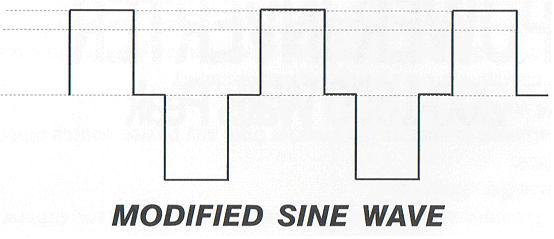- Joined
- 27 Jan 2008
- Messages
- 24,904
- Reaction score
- 2,877
- Location
- Llanfair Caereinion, Nr Welshpool
- Country

We have pure sine wave and modified sine wave and most household appliances will work with either. However it seems some will not. How before buying can one work out what will and what will not run with a modified sine wave?
On a boat because of the problems with catholic protection it is common to have an isolating transformer. I would expect if the output from an inverter giving out a modified sine wave was feed either in parallel or through one of these to would modify the sine wave further getting it closer to the pure waveform would this be enough to allow equipment which will not run with modified sine wave to now work?
Some generators do not connect directly to the output but also go through an inverter so the motor speeds can vary with load so saving on fuel. Or be driven as an auxiliary again the engine speed can vary by output frequency will remain the same. There seems to be very little information as to wave form. Do these generators also have problems due to wave form not being true sine wave?
There are also inverters designed not as stand alone but as a “Grid tie inverter” and from solar panels and the like they feed the existing domestic supply and reduce the power taken from the main supply. Do these modify the sine wave and will these stop some items from working?
Looking at Inverter suppliers and Power-Tek generators they give very little information as to what will and what will not work on a modified sine wave. And walk into a shop selling freezers and ask will this freezer work on a modified sine wave and one is met with a blank expression and “What!!!!” or words to that effect.
So how does one work out what will and what will not work?
is what a modified wave form looks like and is the wave form from inverter generator (They look like modified vehicle alternators) found two one South African the other Siemens (Travel Power 991 00 10-06 package). The latter downloaded PDF but lost site.
Considering my Son and daughter-in-law will want all items to run of modified sine wave I want to work out what we can get them.
On a boat because of the problems with catholic protection it is common to have an isolating transformer. I would expect if the output from an inverter giving out a modified sine wave was feed either in parallel or through one of these to would modify the sine wave further getting it closer to the pure waveform would this be enough to allow equipment which will not run with modified sine wave to now work?
Some generators do not connect directly to the output but also go through an inverter so the motor speeds can vary with load so saving on fuel. Or be driven as an auxiliary again the engine speed can vary by output frequency will remain the same. There seems to be very little information as to wave form. Do these generators also have problems due to wave form not being true sine wave?
There are also inverters designed not as stand alone but as a “Grid tie inverter” and from solar panels and the like they feed the existing domestic supply and reduce the power taken from the main supply. Do these modify the sine wave and will these stop some items from working?
Looking at Inverter suppliers and Power-Tek generators they give very little information as to what will and what will not work on a modified sine wave. And walk into a shop selling freezers and ask will this freezer work on a modified sine wave and one is met with a blank expression and “What!!!!” or words to that effect.
So how does one work out what will and what will not work?
is what a modified wave form looks like and is the wave form from inverter generator (They look like modified vehicle alternators) found two one South African the other Siemens (Travel Power 991 00 10-06 package). The latter downloaded PDF but lost site.
Considering my Son and daughter-in-law will want all items to run of modified sine wave I want to work out what we can get them.


